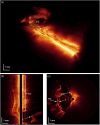Flexible catheter optical coherence tomography of the porcine middle ear via the Eustachian tube using a 3D-printed reflective objective
- PMID: 40621165
- PMCID: PMC12223792
- DOI: 10.1117/1.JBO.30.7.076002
Flexible catheter optical coherence tomography of the porcine middle ear via the Eustachian tube using a 3D-printed reflective objective
Abstract
Significance: Cholesteatomas, benign tumors that grow in the middle ear, can lead to conductive hearing loss. If not completely removed during surgery, these tumors may regrow. Current imaging technologies struggle to detect residual tumors noninvasively due to limitations in contrast and resolution, often necessitating additional surgery for inspection. To address this, we developed a catheter endoscope capable of being inserted through the Eustachian tube, allowing detailed examination of the middle ear without surgery. Using two-photon polymerization (2PP) technology, we fabricated miniature, side-viewing reflective endoscope objectives. This approach enabled the rapid production of single-element objectives with highly repeatable optical properties, easily adaptable to specific imaging needs.
Aim: We aim to design, fabricate, and demonstrate a catheter endoscope for optical coherence tomography (OCT) endoscopy of the middle ear via the Eustachian tube.
Approach: Side-viewing, reflective lenses were designed in OpticStudio and 3D printed using 2PP followed by sputter coating with gold. Standard metrology techniques were used to verify and optimize the objective's shape. The optical performance of the catheter endoscopes was measured with a beam profiler. Finally, OCT imaging of the middle ear of a pig via the Eustachian tube was completed using the fully assembled catheter endoscope.
Results: Metrology showed the printed lenses conformed closely to the design. The catheter endoscope's FWHM spot size had a mean ± standard deviation of with a measured working distance of . Volumetric OCT images of the middle ear, inner ear, and Eustachian tube were captured in a postmortem pig head using the catheter endoscope.
Conclusions: The 2PP approach is fast and highly repeatable for miniature reflective objective fabrication. OCT catheter endoscopy via the Eustachian tube enabled imaging of the middle ear, Eustachian tube, and surprisingly part of the inner ear.
Keywords: additive manufacturing; catheter endoscope; optical coherence tomography; two-photon polymerization.
© 2025 The Authors.
Figures









References
Publication types
MeSH terms
Grants and funding
LinkOut - more resources
Full Text Sources

